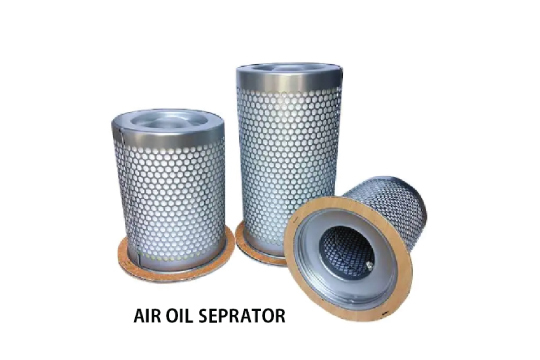-
Call
-
Whatsapp
9825014048
-
Location


Air Oil Separator
Air Oil Separator
Air compressor is essential in various industries, providing vital energy for multiple applications. However, the compression process generates heat and often deposits oil in the compressed air. Air oil filters ensure the quality and efficiency of compressed air systems. In this comprehensive guide, we will explore the world of air oil separators, examining their operation, components, and maintenance, as well as their critical role in keeping compressed air clean and functional in the field.
Air conditioning is ubiquitous in manufacturing, automotive, medical, and other industries. It manufactures energy-efficient tools, machines, and accessories, making it indispensable for many industries. However, a common challenge in compressed air is the presence of oil. This oil can come from various sources, including lubricants used in the compressor, worn compressor parts, and natural oils in the ambient air.
The Presence of Oil in Compressed Air Can Have Many Adverse Effects:
- Reduced Efficiency: Oil can clog internal components, reducing the efficiency of air tools and increasing energy consumption.
- Pollution: Oily gases can cause product contamination in industries such as food and pharmaceuticals.
- Equipment Damage: Oil can damage downstream equipment and machinery, causing costly repairs and downtime.
Air and oil separators are used in compressed air systems to overcome these issues. These separators are designed to remove oil from compressed air, ensuring the supply air is clean, dry and suitable for various applications.
Air Oil Separators
Air oil separation generally consists of several major components, each playing an essential role in the separation process. Together, these processes effectively remove oil particles from the compressed gas.
Business Principle:
- Fusion filter media: Fusion filter media is the heart of air and oil separation. This unit is designed to capture and disperse oil particles suspended in compressed air. It consists of dense fibres or large surface areas, causing oil droplets to coalesce into droplets.
- Housing: The housing, usually made of solid metal or plastic, covers the connecting hole. It provides structural support and ensures compressed air flows through the filter, allowing for separation.
- Air intake and exhaust: Air and oil separators have intake and exhaust air in conjunction with the compressed air system. The inlet port receives lubricated air, while the inlet port delivers clean, oil-free air for downstream use.
- Drainage System: A drainage system is included to remove the separated oil from the separator. This can be automatic, relying on flotation systems or timers, or manual, requiring periodic maintenance to remove deposited oil.
How Air Oil Separators Work
The operation of gas-oil separation is based on the principle of hybridization. Here is a step-by-step breakdown of how it works.
- Step 1: Oily gas inflow: Compressed oil-based gas enters the crack through the inlet port. This gas contains small amounts of oil that must be removed before the gas can be used in consumer applications.
- Step 2: Through the fusion hole: As the compressed gas flows through the fusion hole, the tubes in the filter form a winding path for the gas. In this process, oil droplets in the air collide with filters and other oil particles. This collision and interaction results in the coalescence of oil droplets and the formation of tiny, large, viscous droplets.
- Step 3: Isolation of the oil droplets: The combined oil's current bulk is heavier than the surrounding air's. Due to gravity and the design of a separator, these oil particles will begin to separate from the gas and accumulate at the bottom of the separator chamber.
- Step 4: Clean, oil-free air exhaust: The clean air continues through the collection filter and out of the separator through the exhaust port. This gas is free of most oil impurities and is suitable for various applications.
- Step 5: Oil Drainage (If applicable): In systems with automatic drains, oil stored below the separator is periodically drained to ensure that the separator can continue to operate correctly.
Air Oil Separators
Air oil separators come in various designs and configurations, each tailored to a specific compressor and application. There are two main components:
- Centrifugal Air Oil Separators:Centrifugal separators use centrifugal force to separate oil from compressed air. The separation is accomplished by relying on the difference in density of oil and gas. These explosives are commonly used in large industrial air compressors.
- Combining atmospheric oil separation: Combining systems, as discussed earlier, use filter media to capture and combine oil droplets. They are commonly available in small and large air filters and can easily remove oil.
Maintenance and Replacement
Air oil separators require regular maintenance to remain in good working order. Maintenance work usually includes checking the filter media for congestion or damage, checking and filtering the oil collector (if applicable), and checking the overall condition of the separator. By use and condition work, replacing the fusion filter media may also be necessary.
As technology improves, pneumatic oil separators become more efficient and effective, making them unnecessary in industries where compressed air is an essential operational component where pneumatic oil separators are required to be repaired and regularly reviewed to ensure high-performance.
Adding the proper air oil separator to your compressed air system can make a big difference in the quality of your compressed air and the success of your operations.


FAQ

Frequently Ask Questions
An Air Oil Separator is a vital component in a compressor system designed to separate oil from compressed air, ensuring clean and oil-free air output.
Air Oil Separators function by using various filtration techniques such as coalescing and centrifugal force to remove oil droplets from compressed air, ensuring efficient oil separation.
Regular replacement of Air Oil Separators is critical to maintaining optimal compressor performance, preventing oil carryover, minimizing energy consumption, and extending the lifespan of compressor components.

